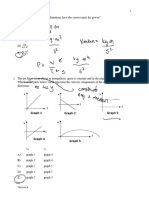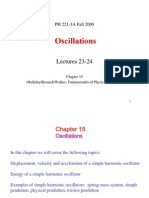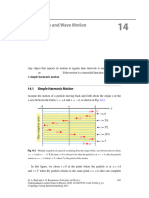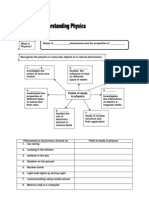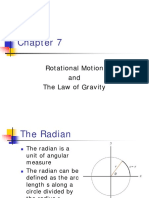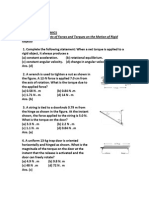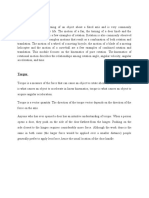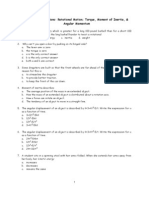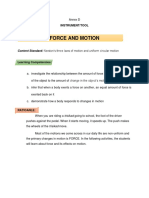Work, Power & Energy (Practice Questions)
Uploaded by
SakshamWork, Power & Energy (Practice Questions)
Uploaded by
SakshamWORK, ENERGY & POWER (SOLVED NUMERICALS) BOARD LEVEL QUSTION BANK
WORK, ENERGY & POWER
2 Marks – I
1. A force F = 10 + 0.5x acts on a particle in the x direction where F is in Newton and x in
meter. Find the work done by this force during a displacement from x = 0 to x = 2.0 m. [2]
2
1.
W = F.dx = (10 + 0.5 x )dx = 21J
0
2. With what minimum speed v must a small ball should be
d
pushed inside a smooth vertical fixed tube from a height h
so that it may reach the top of the tube? Radius of the R
tube is R. (d <<R)
h v
[2]
2. Applying conservation of energy
1
mv2 + mgh = mg . 2R
2
v= 2g(2R − h)
3. Initially half of the chain’s length ( = 4 m) is overhanging, /2
what will be the speed of the chain when it just slips off the
smooth table ? /2
[2]
3. 30 m / s .
4. A body slides down a smooth curved fixed track which
10 m
is a quadrant of a circle with radius 10 m. Find the
speed of the body at the bottom of the track.
10 m
[2]
4. 10 2 m/sec.
5. A force F =3 î + 4 ĵ + k̂ displaces a body from a point with coordinates (1, 2, 1) to another
point with coordinates (2, 0, 3). Calculate the work done by the force. All physical quantities
are in SI units. [2]
5. Displacement vector s = r2 − r1 = î − 2 ĵ + 2k̂
work W = F.S = (3 î + 4 ĵ + k̂ ).( î − 2 ĵ + 2k̂ )
= 3 - 8 + 2 = (-3) J
RK MALIK’S NEWTON CLASSES NEWTONCLASSES.NET
WORK, ENERGY & POWER (SOLVED NUMERICALS) BOARD LEVEL QUSTION BANK
6. Find the average force needed to accelerate a car weighing 200kg from rest to 72 km/h in a
distance of 50m. [2]
6. Now v 2 = u2 + 2as
5
u = 0, v = 72 = 20m / s
18
20 20
Acceleration a = = 4m / s2
2 50
Avg force F = ma = 200 2
F = 400N .
7 An engine develops 5kw of power. How much time will it take to lift a mass of 250 kg to a
height of 50 m. [g=10m/s2] [2]
7. Total energy required to lift mass E=mgh=2501050J
E 250 10 50
time T = =
P 5 103
t = 25 sec
8. An object dropped from a height h strikes the ground with a speed of k gh where
k< 2 . Calculate the work done by air-friction. [2]
8. Work done by gravity = +mgh, work done by air friction = Wf
from work energy principle
1
mgh + wf = change in K.E. = m (k gh )2
2
k 2
k2
wf = - [mgh - mgh ] = - 1 − mgh
2 2
RK MALIK’S NEWTON CLASSES NEWTONCLASSES.NET
WORK, ENERGY & POWER (SOLVED NUMERICALS) BOARD LEVEL QUSTION BANK
9 AOB is a smooth semicircular track of radius r. A block r
B A
of mass m is given a velocity 2rg parallel to track at
point A. Calculate normal reaction between block and
track when block reaches at point O.
1 1 mv 02
9. mv 02 = mv 2A + mgr = 2mg + 2mg = 4mg
2 2 r
mv 02
N = mg + = 5mg
r
10. A block of mass m moves on a vertical track which v0
A m
is convex at A and concave at B as shown in figure.
If the friction is assumed to be negligible, find the R
ratio of the normal reactions at A and B. Velocity at R
the highest point is v0 and radius of curvature at A
and B are equal to R. B
[4]
mv 02 F.B.D. at A
10. Centripetal force = mg − N1 N1
R
mv 02
N1 = mg -
R
mg
Centripetal force FBD at B
N2
2
mv
= N2 - mg,
R
m 2 m
N2 = mg + ( v 0 + 2g.2R) = mg + ( v 02 + 4gR ) mg
R R
N1 gR − v 0 2
gR − v 0
2
= = .
N2 gR + v 02 + 4gR 5gR + v 02
11. A self propelled vehicle of mass M whose engine delivers constant power P has an
acceleration a = P/mv. To increase the velocity of the vehicle from v1 to v2, find the distance
travelled by it (assuming no friction is present) [2]
P
11. Since a =
mv
dv 2
or, P = m v
dx
or, Pdx = mv2 dv
integrating both side
m 3
Px = ( v 2 − v 13 )
3
m 3
x= ( v 2 − v 13 )
3P
RK MALIK’S NEWTON CLASSES NEWTONCLASSES.NET
WORK, ENERGY & POWER (SOLVED NUMERICALS) BOARD LEVEL QUSTION BANK
12. A body of mass m dropped from a certain height strikes a light vertical fixed spring of stiffness k. Find
the height of its fall before touching the spring if the maximum compression of the spring is equal to
3mg/k.
12. The change in potential energy between A and B = -mg (h + A
x)
The change in K. E. between A and h
B =0
The change in spring potential energy x
= (1/2) kx2 B
1 k k
−mg (h + x) + 0 + kx2 = 0 h+x= x2
2 2mg
k 3mg 3mg
2
k
h= x2 - x = − k .
2mg 2mg k
3mg
h= .
2k
13. A particle is projected with velocity v and at angle from the horizontal. Find the
instantaneous power delivered by the gravity at the highest point. [2]
13. Pins = F.v
F = −mgj,ˆ v = u cos ˆi
Pins = 0
14. A particle of mass m is dropped from a certain height with a initial horizontal velocity v 0
consider gravitational acceleration g to be constant everywhere. Find kinetic energy of the
particle after time t before striking on the ground. [2]
14. vx (horizontal) = v0
vy (vertically downward) = gt
v2 = v 2x + v 2y = v 02 + (gt )2
1 1
K.E. of particle after time ‘t’ = mv2 = m( v 02 + (gt )2 )
2 2
15. A man weighing 60 kg climbs up a stair case carrying a 20 kg load on his head. The stair
case has 20 steps and each step has a height of 20 cm. If he takes 10 sec. to climb,
calculate the power.
15. Work done = mgh = 8010200.2
= 3200J
3200
Power = = 320 Watt
10
16. An ideal massless spring 's' can be compressed 1.0 m by a 100 N
force. It is placed as shown at the bottom of a frictionless inclined s
plane which makes an angle of = 300 with the horizontal. A 10 kg
block is released from rest from the top of the incline and is brought = 300
to rest momentarily after compressing the spring 2.0 m. Through
what distance does the mass slide before coming to rest ?
RK MALIK’S NEWTON CLASSES NEWTONCLASSES.NET
WORK, ENERGY & POWER (SOLVED NUMERICALS) BOARD LEVEL QUSTION BANK
16. Spring constant = 100N/m
Conserving energy s
mg (x + 2)sin30 = K. (2 )
1 2
2 = 300
1 1
1010(x + 2) = 100 4
2 2
x+2=4
x = 2m along the inclined surface.
17. A 2kg block initially at rest is dropped from a height of 0.4 m onto a spring whose force
constant is 2000 N/m. Find the maximum distance the spring will be compressed.
1 2
17. mg (h + ) = k
2
1
2 10 (0.4 + ) = 2000 2
2
50 2 - - 0.4 = 0
2502 - 5 - 2 = 0
250 2 - 25 + 20 - 2 = 0
25 (10 - 1) + 2 (10 - 1) = 0
(25 + 2) (10 - 1) = 0
= 0.1 m as it can't be - ve
18. A chain is held on a frictionless table with 1/nth of its length hanging over the edge. If the
chain has a length and mass M. how much work is required to pull the hanging part back
on the table
18. Work done = increase in potential energy
M Mg
= g =
n 2n 2n2
19. A block of mass m is attached to two unstretched springs k1 k2
of spring constant k1 and k2 as shown in figure. The m
block is displaced towards right through a distance 'x'
and is released. Find the speed of the block as it passes
through a distance x/4 from its mean position. [5]
19. Applying conservation of energy
1 1 1 1 1
k1x 2 + k 2 x 2 = mv 2 + k1( x / 4)2 + k 2 ( x / 4)2
2 2 2 2 2
x
v= 15(k1 + k 2 ) .
4m
RK MALIK’S NEWTON CLASSES NEWTONCLASSES.NET
WORK, ENERGY & POWER (SOLVED NUMERICALS) BOARD LEVEL QUSTION BANK
2 Marks – II
1. A projectile is fired from the top of a tower 40 meter high with an initial speed of 50 m/s at an
unknown angle. Find its speed when it hits the ground. [3]
1 1
1. Initial K.E. = m.u2 = m.50 2
2 2
1
Final K.E. = mv 2
2
Work done by gravity = +mgh = mg. 40
From w~E principle
1
mg . 40 = kf - kI = m(v2 - 502)
2
v = 57.4 m/s.
2 A body of mass 1kg is projected with a velocity M
v = 5 m/s from the surface of earth at an angle
of = 600 with the horizontal. What is the 0
60 N
power developed by the gravitational force at
O
the following instants [4]
(a) At point M (highest point)
(b) At point N
2. Power = Force. velocity = F v
Pm = mg.v cos90 = mg v cos60 cos90 = 0
PN = mg.v = mgv cos30
3
= 1 105 = 25 3 Watt.
2
3. A bob of mass 'm' is suspended by a light inextensible string of length 'l' from a fixed point.
The bob is given a speed of 6gl . Find the tension in the string when string deflects
through an angle 1200 from the vertical.
3. By C.O.E .theorem B
v
1 1
mu2 = mgl(1 − cos 120 ) + mv 2
2 2 T
mg
gives v = 3gl 120
0
at point B,
mv 2 l
T + mg cos 600 = A
l
by putting v = 3gl
u= 6gl
5
we get, T = mg .
2
RK MALIK’S NEWTON CLASSES NEWTONCLASSES.NET
WORK, ENERGY & POWER (SOLVED NUMERICALS) BOARD LEVEL QUSTION BANK
4. Consider the arrangement shown in the C
figure. If the system is set free at t = 0 A
with the horizontal bar at a height of h as B
h
shown in the figure, obtain
(i) velocities of the wedges A and B at the instant C hits the floor.
(ii) Force exerted by the bar C on each of the wedge.
(Neglect any friction. Mass of each wedge is m while that of C is M) [6]
4. (i) From the figure shown y
L/2
2y
2x + =L
tan
O
dx 1 dy x
+ =0
dt tan dt
y/tan x y/tan
dy dx
= − tan
dt dt
If v and u be the magnitudes of the velocities of bar and wedges then
v = utan . . . (i)
or h = X tan
X = horizontal displacement of each wedge when the bar come down by h
1 1
Mgh = Mv2 Mv2 + 2 mu2 . . . (ii)
2 2
2 M tan 2 gh
From (i) and (ii) Velocity of bar c when it strikes floor =
M tan 2 + 2 m
2Mgh
Speed of wedges at the same instant =
M tan 2 + 2m
(ii) Workdone by N sin on the system of the wedge
N cos
1
N sin . X = mu2 (Work energy theorem) N
2 N sin
1
N sin . X = mu2 (Work energy theorem)
2
1 2Mgh
N sin . X = m.
2 M tan 2 + 2m
Mmg sec
which gives N =
M tan 2 + 2m
5. An object dropped from a height h strikes the ground with a speed of k gh where k < 2.
Calculate the work done by air-friction. [2]
5. Work done by gravity = +mgh, work done by air friction = Wf
from work energy principle
1
mgh + wf = change in K.E. = m (k gh )2
2
k 2
k2
wf = - [mgh - mgh ] = - 1 − mgh
2 2
RK MALIK’S NEWTON CLASSES NEWTONCLASSES.NET
WORK, ENERGY & POWER (SOLVED NUMERICALS) BOARD LEVEL QUSTION BANK
6. A cabin is moving upwards with a constant acceleration g. A
g
boy standing in the cabin wants to whirl a particle of mass m in a
vertical circle of radius . (mass is attached to an ideal string)
calculate minimum velocity which should be provided at
lowermost point (w.r.t cabin) so that particle can just complete
the circle.
6. At top most point,
mv 2
T + 2mg =
r
In critical condition, v2 = 2rg
Applying conservation of energy (or work energy theorem) between top and bottom points.
1 1
mu2 = mv 2 + mg2r + mg.2r
2 2
u2 = v2 + 8gr = 10 gr
u = 10gr
7. Two blocks of masses m1 and m2 connected by a non-deformed
light spring rest on a horizontal plane. The coefficient of friction
between the blocks and the surface is equal to . What m1 m2
minimum constant force has to be applied in the horizontal
direction to the block of mass m1 in order to shift the other [4]
block?
7. kx0 = m2g …(i)
1
Fx0 = m1 gx0 + kx 02 … (ii)
2
m2g
F = m1g +
2
RK MALIK’S NEWTON CLASSES NEWTONCLASSES.NET
WORK, ENERGY & POWER (SOLVED NUMERICALS) BOARD LEVEL QUSTION BANK
4 Marks – I
1. A system consists of two blocks of mass m each
m
connected to a spring of constant k is placed on ground.
For what minimum value of the initial compression in the
spring the system will bounce off.
K
[6]
1. For bounce off
mg
kx = mg x=
k
1
mg (x + x0) = k( x 02 − x 2 )
2
mg kx 02 m2g2
mg. + mgx 0 = − k
k 2 2k 2
kx 02 3 m2g2
− mgx − =0
2 2 k
mg m2g2 + 3m2g2
x0 =
k
3mg
= .
k
2. A body of mass 1kg is projected with a velocity v = 5
m/s from the surface of earth at an angle of = 600 with
the horizontal. What is the power developed by the
1 600
gravitational force at t = sec.
300
2 3
(Given angle of the plane with horizontal is 300) [4]
1
2. t= sec. y x
2 3
1
thus v = 5 cos 600 î + (5 sin 600 – 10 )jˆ g sin 300
g cos 300
2 3 0
300
30
5 3 5 25 300 g
P = mg ( − ˆj).v = -1 10 − = − J/s.
2
3 3
3. A particle is suspended from a fixed point by a inextensible string of length 5 m. It is
projected from its lowest position in the horizontal direction in a vertical plane with such
velocity that the string slackens after the particle has reached a height 8 m above the lowest
position. Find the velocity of the particle, just before the string slackens. Find also to what
height the particle can rise further. [4]
RK MALIK’S NEWTON CLASSES NEWTONCLASSES.NET
WORK, ENERGY & POWER (SOLVED NUMERICALS) BOARD LEVEL QUSTION BANK
vQ cos
3. Equation of motion along radius at point Q.
mv 2
T + mg sin =
90− Q
When the string slackens i.e. T = 0 T
mg sin
3m
mv 2 mg
0 + mg sin =
3 5m
vQ = g sin = 10 5 = 30 = 5.48 m/s
5
P
Vertical velocity at point Q = vQ cos
v2 = u2 + 2gh
0 = v Q2 cos2 + 2(−g)h
v Q2 cos 2 30 16 25 24
h= = = m
2g 2 10 25
4. A particle is displaced from a position ( 3iˆ + 2ˆj + 5kˆ )m to a position ( 5iˆ + 3ˆj + 7kˆ ) m by the
application of a force of magnitude 13 N. Force is directed along ( 12iˆ + 3ˆj + 4kˆ ). Find the
work done by the force. [4]
4. r = r2 − r1 = (5iˆ + 3ˆj + 7k)
ˆ − (3iˆ + 2jˆ + 5k)
ˆ
( 2iˆ + ˆj + 2k)
ˆ m
12iˆ + 3ˆj + 4kˆ
Unit vector along F, F̂ =
122 + 32 + 42
(12iˆ + 3ˆj + 4k)
ˆ
F = F.Fˆ = 13 = (12iˆ + 3ˆj + 4k)N
ˆ
13
Work done = F. r = 35 Joule.
5. A small ball A slides down the quadrant of a circle as A O
shown in the figure and hits the ball B of equal mass
which is initially at rest. Find the velocities of both ball
B
after collision. Neglect the friction and assume the
collision to be elastic?
[4]
1
5. mgh = m u12 u1 = 140 cm/sec.
2
mu1 = mv1 + mv2 … (i)
v − v1
1= 2 … (ii)
u1 − u2
from the above equations
v1 = 0, v2 = 140 cm/sec.
m
6. A bob of mass m is hanging from a light string of length 0.4 m. A bullet of mass hits the
100
bob with a velocity 400 m/sec perpendicularly to the string and passes out with half of the
initial velocity Find the maximum angle of deflection of the string from the vertical. [4]
RK MALIK’S NEWTON CLASSES NEWTONCLASSES.NET
WORK, ENERGY & POWER (SOLVED NUMERICALS) BOARD LEVEL QUSTION BANK
6. Conserving linear momentum of bob + bullet system O
m m v0
v0 = + mv
100 100 2
where v is the velocity of bob just after collision
solving v = v0 / 200
using COE just after collision
1
m( v )2 = mg(1 − cos )
2
2
1 v
0 = g(1 − cos )
2 200
on solving we get = 600
7. A small ball is suspended from point O by a thread of length . A nail is driven into the wall
at a distance of /2 below O, at A. The ball is drawn aside so that the thread takes up a
horizontal position at the level of point O and then released. Find
(a) At what angle from the vertical of the ball’s trajectory, will the tension in the thread
disappear?
(b) What will be the highest point from the lowermost point of circular track, to which it will
rise? [2+2=4]
7. If at point P, tension is zero. O
vp
mv 2
then mg cos = /2
r P
Using conservation of energy,
v2 = g (1 – cos) A
mg
mg cos = (1 − cos )
/2
= cos-1(2/3)
height of point
5
P = + cos = , from lowest point.
2 2 6
2 g g
v2 = g1 − = v=
3 3 3
Now the particle describes parabolic path.
The height attained by the particle, from point P.
h=
(v sin )2 = 5
2g 54
highest point from lowest point will be
5 5 50
+ = .
6 54 54
RK MALIK’S NEWTON CLASSES NEWTONCLASSES.NET
WORK, ENERGY & POWER (SOLVED NUMERICALS) BOARD LEVEL QUSTION BANK
8. Two smooth wedges of equal mass m are placed as shown in
figure. All surfaces are smooth. Find the velocities of A & B
when A hits the ground.
A B
h
8. Writing constraint relation
yA = yB tan yA
differentiate w.r.to. t we get
vA = vB tan … (i)
yB
using COE,
1 1
mgh = m( v B )2 + mv 2A … (ii)
2 2
putting value vA in equation (ii) and solving we get
vB = 2gh cos , vA = 2gh sin
9. A block of mass m is droped onto a spring of constant m
h
k from a height ‘h’. The second end of the spring is
attached to a second block of mass M as shown.
Find the minimum value of h so that the block M
bounces off the ground. if the block of mass m sticks
to the spring immediately after it comes into contact
with it. M
[8]
9. The block m drops a height h from A compresses the A
x
spring and then goes up to B x above the initial level h B
of spring. Applying work energy theorem between A
and B x
W = PEs + PEg + kE + wNC
N kx
1
0 = - mg (h –x) + kx2 + 0 + 0
2
1
mg (h – x) = kx2
2
Mg
Minimum value of x required so that the block bounces is when the N will become zero
Mg
N + kx = Mg N=0 x=
k
2 2
Mg 1 Mg M2g2 mMg 2
mg (h - ) = k. mgh = +
k 2 k2 2k k
(M2 + 2mM)g
h=
2km
This is the required minimum value of h.
10. A smooth table is placed horizontally and an ideal spring of spring constant K = 1000 N/m
and unextended length of 0.5 m has one end fixed to its centre. The other end is attached to
a mass of 5 kg which is moving in a circle with constant speed 10 m/s. Find the tension in
the spring and its extension beyond normal length. [10]
10. Radius of circular path = r = l + x
RK MALIK’S NEWTON CLASSES NEWTONCLASSES.NET
WORK, ENERGY & POWER (SOLVED NUMERICALS) BOARD LEVEL QUSTION BANK
where l = natural length of the spring
x = extension in the spring
spring force = Kx
mv 2 5(10 )2
Kx = 1000x =
r 0.5 + x
500x + 1000x2 = 500
or 1000x2 + 500x – 500 = 0
2x2 + x – 1 = 0
2x2 + 2x – x – 1 = 0, 2x (x + 1) – 1(x + 1) = 0
x = -1, absurd 2x = 1 or x = 1/2 m
11. Two masses ‘m’ and ‘2m’ are connected
by a massless string which passes over
A
a light frictionless pulley as shown in
10 cm
fig.1. The masses are initially held with 10 cm
equal lengths of the strings on either side
B
of the pulley. Find the velocity of the m 2m
masses at the instant the lighter mass Fig. 2
13.08 m
moves up a distance of 6.54 m. The ground
string is suddenly cut at that instant. Fig. 1
Calculate the time taken by each to
reach the ground. (g = 9.81 m/s2)
11. T
FBD of m; and T – mg = ma …(1)
mg
T
FBD of 2m; and 2mg – T = 2ma …(2)
2mg
Adding (1) and (2) mg = 3ma
a = g/3
Hence velocity of ‘m’ after moving up 6.54 m is;
9.81
V2 = 2 (g/3) (6.54) = 2 (6.54) = 2(3.27) (6.54)
3
V = 6.54 m/s upwards
Velocity of ‘2m’ at that instant = 6.54 m/s downwards.
When string is cut ‘m’ falls to the ground from a height of 13.08 + 6.54 = 19.62 m
19.62 = – 6.54 t+ 1/2 (9.81) t2 where ‘t’ is the time taken to reach the ground
t = 2.7 seconds
‘2m’ falls a distance of 13.08 – 6.54 = 6.54 m
t = 0.6 seconds
12. An object of mass 5 kg falls from rest through a vertical distance of 20 m and reaches a
velocity of 10 m/s. How much work is done by the push of the air on the object? [8]
RK MALIK’S NEWTON CLASSES NEWTONCLASSES.NET
WORK, ENERGY & POWER (SOLVED NUMERICALS) BOARD LEVEL QUSTION BANK
12. FBD of the object falling; F
F is the push of the air
mg – F = ma where mg – F is the net force acting on the object
a
Initial velocity = 0 Final velocity = 10 m/s
Distance through which the object has fallen = 20m mg
Applying W.E. equation
(mg – F)20 = 1/2m (102) – 0
50 20 – 20F = 50 (5)
1000 –250 = 20F
750 75
F= = N
20 2
work done by the push of the air
75
=– (20) = – 750 joules
2
13. A block of mass 'm' is pushed against a spring of spring k m
constant k fixed at other end to a wall. The block can slide on a
frictionless table as shown. The natural length of the spring is
L0. It is compressed to half its natural length and released. L0/2
Find the velocity of the block as a function of its distance from
the wall.
13. Here initial compression = L0/2
2
1 L
energy stored in the spring = k 0
2 2
1 2
= kL 0
8
as it moves a small distance x, say the velocity it has is v and so
2
1 L0 1 1
k − x + mv 2 = kL20
2 2 2 8
1 2 1 1
kx - k(L0 x) + mv2 = 0
2 2 2
kx2kL0x + mv2 = 0
kx2 – kL0x + mv2 = 0
[L x − x 2 ]k
v2 = 0
m
k(L 0 x − x 2 )
or v=
m
RK MALIK’S NEWTON CLASSES NEWTONCLASSES.NET
WORK, ENERGY & POWER (SOLVED NUMERICALS) BOARD LEVEL QUSTION BANK
4 Marks – II
1. A small cube of mass m slides down a circular path of radius m
R on the surface of a larger block of mass M, as shown in the
R
figure. M rests on a table, and both blocks move without
friction. The blocks are initially at rest, and m starts from the
top of the path. Find the velocity of the cube as it leaves the M
block.
[6]
1. Let v1 and v 2 be the final velocities of the cube
R
and block with respect to the ground respectively.
m
Momentum conservation : m v1 = - M v 2 v2 v1
M
Energy conservation :
1 1
mgR = Mv 22 + mv12
2 2
2MgR
After solving, v1 =
M+m
2. A small block of mass m slides along a frictionless loop B
inside loop track as shown in figure. Find the minimum
ratio R/r so that the block may not lose contact at the R
highest point of inner loop. r
A [4]
2. Velocity at A = 2gR
Critical velocity at A = 5gr
5gr = 2gR
R 5
=
r 2
3. A small disc of mass m slides down a m
smooth hill of height h without initial
velocity and gets onto a planck of mass M
lying on the horizontal plane at the base
of the hill, as shown in the figure. Due to h
friction between the disc and the plank,
the disc slows down and ultimately, both
M
move together.
(a) Find the common velocity of the disc and the planck.
(b) Find the work done by the friction
(c) Find the distance moved by the disc with respect to the planck before they start moving
together.
RK MALIK’S NEWTON CLASSES NEWTONCLASSES.NET
WORK, ENERGY & POWER (SOLVED NUMERICALS) BOARD LEVEL QUSTION BANK
3. (a) Velocity of the disc at the foot of N
the hill is v0 = 2gh . When it slides
on the plank, friction opposes its f
motion and favours the motion of ms
N
the plank as shown in the figure. f
Let their common velocity be V, then
for m, V = v0 - gt
mgt
for M, V=
M
Eliminating t from the above two equations,
mv 0
V=
m+ M
(b) Using Work - Energy theorem
Wf = Kf - Ki
1 1
Wf = (m + M)V2 - mv02
2 2
2
1 mMv 0 mMgh
=- =-
2 m+ M m+ M
(c) Acceleration of the disc w.r.t the plank is
m m + M
arel = g + g = g
M M
u 2rel Mv 20 Mh
xrel = = =
2 a rel 2g( m + M) ( m + M)
4. A blocks of mass m is suspended through a spring of spring constant k and is in equilibrium.
A sharp blow gives the block an initial downward velocity v. How far below the equilibrium
position, the block comes to an instantaneous rest ? [4]
4. When the block is in equilibrium, then kx = mg ; x = mg / k
2
1 mg
initial P.E. of the spring =k
2 k
Next, Total energy of the system just after the blow
1 m2 g2 1
= + mv 2
2 k 2
Total energy of the system after the maximum extension
2
1 mg
=k + h − mgh
2 k
From the law of energy conservation
2
1 m2 g2 1 1 mg
+ mv 2 = k + h − mgh
2 k 2 2 k
m
h= v .
k
RK MALIK’S NEWTON CLASSES NEWTONCLASSES.NET
WORK, ENERGY & POWER (SOLVED NUMERICALS) BOARD LEVEL QUSTION BANK
5. See the diagram, the system is in equilibrium. There is
no friction anywhere. Spring, string, pulley are massless. m
Find spring compression. k
M
[4]
5. FBD of block FBD of wedge
T T T cos
N
T sin
N sin
N1
mg sin
F
mg cos N cos
mg
Equation of motion for the block:
T – mg sin = 0 along inclined plane …(i)
N – mg cos = 0 perpendicular to the inclined plane …(ii)
For the wedge
T + N sin - T cos - F = 0 Horizontally (F is spring force)
From (i), (ii) and (iii) ;
F = mg sin
mg sin
Hence, compression= .
k
O
6. A body starts moving from the highest point of
the smooth curved surface horizontal at the end
as shown in figure without losing contact. Find P
out the horizontal distance moved by the body H =5m h =1m
after breaking off at point P from the curved
surface. x
[4]
1
6. 0 + mgH = mv 2 + mgh
2
1
mg (H − h) = mv 2
2
v2 = 2g (H − h)
v= 2 10(5 − 1) = 80 m/s
1 2
For time h = 0 + gt
2
2h 2 1 1
t= = = sec
g 10 5
Now x = v. t
1
x = 80 . = 16
5
x=4m
RK MALIK’S NEWTON CLASSES NEWTONCLASSES.NET
WORK, ENERGY & POWER (SOLVED NUMERICALS) BOARD LEVEL QUSTION BANK
7. A particle is suspended vertically from a point O by an O
A
inextensible massless string of length 'L'. A vertical line AB
is at a distance L/8 from O as is shown. A horizontal velocity
'u' is imparted to the particle. At horizontal velocity 'u' is L L/8
imparted to the particle. At some point its motion ceases to
be circular and eventually the object passes through line AB.
At the instant of crossing AN, its velocity is horizontal. Find u B
out the value of 'u'.
[10]
7. It is clear from the statement of the problem that the A
v
particle has the circular path before it crosses the line P
AB second time, during its upward motion.
O
Let us assume that the particle have the circular path
at 'P' and v is the velocity of the particle at P.
Then, conservation of mechanical energy at P and at B
the lowest point yields :
1 1
mv2 = mv2 + mgL (1 + sin ) . . . (i)
2 2
1 1
mu2 = gL (1 + sin ) + mv 2
2 2
mv 2
At point: P T + mg sin = , If T becomes zero :
L
v2 = gL sin . . . (ii)
After having the circular path, the particle moves along a parabolic trajectory as a projectile.
As it is given that velocity of the particle when it crosses AB is horizontal, it is clear that,
when it is crossing AB, it is passing through its highest point in the parabolic path.
L
Hence, half of the range of this projectile path = L cos -
8
As projection angle of the particle with respect to horizontal time atP = (90 0 - ), therefore,
v 2 sin 2(90 − )
maximum range =
g
1 v 2 sin 2(90 − ) L
Hence, = L cos - . . . (iii)
2 g 8
1
From (ii) and (iii) : cos = = 600
2
Using this information and (I) and (ii),
4 + 3 3
u= gL .
2
RK MALIK’S NEWTON CLASSES NEWTONCLASSES.NET
WORK, ENERGY & POWER (SOLVED NUMERICALS) BOARD LEVEL QUSTION BANK
4 Marks – III
1. A small ball B, of mass MB, is suspended through a massless A
rigid rod of length and is attached to plank A of mass mA.
The plank is free to slide on a frictionless horizontal track. If
the ball is given an initial horizontal velocity vo when the plank
was at rest, determine,
B vo
(a) the velocity of ball B as it reached its maximum elevation,
(b) the maximum vertical distance h through which B will rise [4+4]
1. (a) Applying conservation of momentum along horizontal A v1
direction.
mBvo = (mA + mB)v1
mB v o
v1 =
m A + mB
B vo
(b) Applying energy conservation
1 1
mBV o2 + mAg = (mA + mB)v 12 + mAg + mBgh
2 2
mA vo
2
h =
m A + mB 2g
2. A train starting from rest is moving along a straight track with a constant acceleration of
2.5 m/s2. A passenger at rest in the train observes a particle of mass 2 kg to be at rest on
the floor with which it has a coefficient of friction s = k = 0.5. Six seconds after the starting
of the train, a horizontal force F = 13 N is applied to the particle for two seconds duration.
The passenger now observes the particle to move perpendicular to the direction of the train.
(a) calculate the kinetic energy of the particle with respect to the passenger at the end of 8
seconds after starting of the train.
(b) repeat the calculation of (a) for an observer on the ground. [4]
2. (a) as f f and F.B.D. of block in the train’s reference frame for
0<t6s
1
f = s mg = ( 2 ) (10 ) N = 10 N N
2
Where as ma = (2) (2.5) N = 5 N
acceleration
ma f
mg
F.B.D. (i)
The block remains at rest with respect to train during 0 < t 6 sec.
During this time interval , as given in the
problem the block moves normal to the F.B. D. of block for t > 6 s
direction of acceleration of train , the F
FR
applied force F must be directed such
Direction of acceleration
as to give the FR (resultant of all but of train
frictional forces) normal to a as shown ma
in the free body diagram. (The weight f F.B.D.(ii)
and normal reaction for F.B.D.(ii) are
directed normal to the plane of figure)
Now sin = ma/F = 5/13
RK MALIK’S NEWTON CLASSES NEWTONCLASSES.NET
WORK, ENERGY & POWER (SOLVED NUMERICALS) BOARD LEVEL QUSTION BANK
But FR = Fcos = F 1 − sin2 = 12 N
FR (Resultant of total external force) = FR - fk = 2 N
F'R − fk
Acceleration ‘a’ of block = = 1 m/s2
m
Velocity t seconds after the force is applied = a t1, where t1 = 2 s
1
KE at (t = 8 sec) = m ( a' t1 )
2
2
Putting the values we get KE = 4 J.
(a' t ) + ( at )
2 2
(b) Speed of the block in ground reference frame = 1
where t = 8 s
= 4 + 400 = 404 m/s
1
( 2) ( )
2
Hence KE of block at t = 8 sec in ground’s reference frame = 404 = 404J .
2
RK MALIK’S NEWTON CLASSES NEWTONCLASSES.NET
You might also like
- Virtual Lab-Conservation of Momentum in Inelastic CollisionsNo ratings yetVirtual Lab-Conservation of Momentum in Inelastic Collisions3 pages
- Proceedings-Vol 09 No 13-April-May-June-1973 (George Van Tassel)80% (5)Proceedings-Vol 09 No 13-April-May-June-1973 (George Van Tassel)16 pages
- Uniform and Non - Uniform Circular MotionNo ratings yetUniform and Non - Uniform Circular Motion4 pages
- Newton's Universal Law of Gravitation: A Lecture On General Physics 1 by Engr. Jackielou D. DecenaNo ratings yetNewton's Universal Law of Gravitation: A Lecture On General Physics 1 by Engr. Jackielou D. Decena53 pages
- Chapter Two: Kinematics and Dynamics of ParticlesNo ratings yetChapter Two: Kinematics and Dynamics of Particles129 pages
- 11 Physics Chapter 14 and 15 Assignment 5No ratings yet11 Physics Chapter 14 and 15 Assignment 52 pages
- Topic 4 1 Kinematics of Simple Harmonic MotionNo ratings yetTopic 4 1 Kinematics of Simple Harmonic Motion31 pages
- Rotational Motion and The Law of GravityNo ratings yetRotational Motion and The Law of Gravity47 pages
- Elasticity, Heat and Thermodynamics KS13 2021No ratings yetElasticity, Heat and Thermodynamics KS13 202150 pages
- PHYSICS Review Guide 2D Motion: M - L B NNo ratings yetPHYSICS Review Guide 2D Motion: M - L B N4 pages
- Work, Energy & Power Questions With Answers AU Special SchoolNo ratings yetWork, Energy & Power Questions With Answers AU Special School8 pages
- Fundamental Forces in Nature: Presented By, Harsh Salunkhe Xi Science100% (1)Fundamental Forces in Nature: Presented By, Harsh Salunkhe Xi Science11 pages
- Multiple-Choice Question 1985 Take G 10 m/s2.: Velocity/msNo ratings yetMultiple-Choice Question 1985 Take G 10 m/s2.: Velocity/ms16 pages
- Net Force: Physics 11 M. Lam Name: BlockNo ratings yetNet Force: Physics 11 M. Lam Name: Block2 pages
- Best Coaching Institute For Iit-Jee Booklet (Work, Energy and Power)No ratings yetBest Coaching Institute For Iit-Jee Booklet (Work, Energy and Power)50 pages
- SACE Stage 2 Physics Uniform Circular Motion: F V M R 10) 0 - 1) (0 - 1 (R 2 V V R 2 T 0 - 1) 1 - 0 (2100% (1)SACE Stage 2 Physics Uniform Circular Motion: F V M R 10) 0 - 1) (0 - 1 (R 2 V V R 2 T 0 - 1) 1 - 0 (23 pages
- Chapter - 7 - Potential Energy and Energy Conservation - R K ParidaNo ratings yetChapter - 7 - Potential Energy and Energy Conservation - R K Parida8 pages
- Work Power Energy + Conservation of Linear Momentum Collision and Centre of MassNo ratings yetWork Power Energy + Conservation of Linear Momentum Collision and Centre of Mass22 pages
- Module Exercise 2 - WEP Vertical Circular Motion 1731005321176No ratings yetModule Exercise 2 - WEP Vertical Circular Motion 173100532117611 pages
- JEE Main 2023 Important Questions _ Work, Energy and PowerNo ratings yetJEE Main 2023 Important Questions _ Work, Energy and Power20 pages
- Mechanical Properties of Solids Worksheet (Fully Solved)No ratings yetMechanical Properties of Solids Worksheet (Fully Solved)25 pages
- Thermodynamics Worksheet (Fully Solved)No ratings yetThermodynamics Worksheet (Fully Solved)22 pages
- Kinetic Theory Worksheet (Fully Solved)No ratings yetKinetic Theory Worksheet (Fully Solved)22 pages
- Mechanical Properties of Fluids Worksheet (Fully Solved)No ratings yetMechanical Properties of Fluids Worksheet (Fully Solved)30 pages
- System of Particles and Rotational Dynamics Worksheet (Fully Solved)No ratings yetSystem of Particles and Rotational Dynamics Worksheet (Fully Solved)42 pages
- Work, Energy and Power Worksheet (Fully Solved)No ratings yetWork, Energy and Power Worksheet (Fully Solved)44 pages
- Colloids: Office.: 606, 6th Floor, Hariom Tower, Circular Road, Ranchi-1, PH.: 0651-2562523, 9835508812, 8507613968No ratings yetColloids: Office.: 606, 6th Floor, Hariom Tower, Circular Road, Ranchi-1, PH.: 0651-2562523, 9835508812, 850761396816 pages
- Laws of Motion Worksheet (Fully Solved)No ratings yetLaws of Motion Worksheet (Fully Solved)41 pages
- General Principles and Processes of Isolation of ElementsNo ratings yetGeneral Principles and Processes of Isolation of Elements13 pages
- Rotational Motion (Practice Questions PDFNo ratings yetRotational Motion (Practice Questions PDF46 pages
- Simple Harmonic Motion (Practice Questions)100% (1)Simple Harmonic Motion (Practice Questions)29 pages
- CBSE Sample Paper Class 9 Science SA2 Set 1No ratings yetCBSE Sample Paper Class 9 Science SA2 Set 15 pages
- Paper of The Circular Motion and Gravitation: Lecturer: Dr. Sc. Syahril, S.Si, MTNo ratings yetPaper of The Circular Motion and Gravitation: Lecturer: Dr. Sc. Syahril, S.Si, MT25 pages
- Identify The Choice That Best Completes The Statement or Answers The QuestionNo ratings yetIdentify The Choice That Best Completes The Statement or Answers The Question4 pages
- Is There A Coriolis Force in North Pole?No ratings yetIs There A Coriolis Force in North Pole?21 pages
- Cambridge IGCSE Physics Workbook (3rd Edition)100% (2)Cambridge IGCSE Physics Workbook (3rd Edition)128 pages
- General Supplementary Notes in Science 8: Unbalanced ForceNo ratings yetGeneral Supplementary Notes in Science 8: Unbalanced Force4 pages
- Physics: University of Cambridge International Examinations International General Certificate of Secondary EducationNo ratings yetPhysics: University of Cambridge International Examinations International General Certificate of Secondary Education12 pages
- Session 3 Kinetics of Particles Work Energy PrincipleNo ratings yetSession 3 Kinetics of Particles Work Energy Principle34 pages
- Quick Strip Theory Calculations in Ship DesignNo ratings yetQuick Strip Theory Calculations in Ship Design11 pages
- Immediate Download Proteome Informatics Conrad Bessant Ebooks 2024100% (5)Immediate Download Proteome Informatics Conrad Bessant Ebooks 202454 pages
- Full Einstein S Monsters The Life and Times of Black Holes Chris Impey PDF All Chapters100% (5)Full Einstein S Monsters The Life and Times of Black Holes Chris Impey PDF All Chapters52 pages
- Sample Paper (Class - 10) : EYSE (AY 2020 - 2021) PhysicsNo ratings yetSample Paper (Class - 10) : EYSE (AY 2020 - 2021) Physics14 pages
- Chapter 4 Force and Motion (II) : Addition and Resolution of ForcesNo ratings yetChapter 4 Force and Motion (II) : Addition and Resolution of Forces10 pages
- Virtual Lab-Conservation of Momentum in Inelastic CollisionsVirtual Lab-Conservation of Momentum in Inelastic Collisions
- Proceedings-Vol 09 No 13-April-May-June-1973 (George Van Tassel)Proceedings-Vol 09 No 13-April-May-June-1973 (George Van Tassel)
- Newton's Universal Law of Gravitation: A Lecture On General Physics 1 by Engr. Jackielou D. DecenaNewton's Universal Law of Gravitation: A Lecture On General Physics 1 by Engr. Jackielou D. Decena
- Work, Energy & Power Questions With Answers AU Special SchoolWork, Energy & Power Questions With Answers AU Special School
- Fundamental Forces in Nature: Presented By, Harsh Salunkhe Xi ScienceFundamental Forces in Nature: Presented By, Harsh Salunkhe Xi Science
- Multiple-Choice Question 1985 Take G 10 m/s2.: Velocity/msMultiple-Choice Question 1985 Take G 10 m/s2.: Velocity/ms
- Best Coaching Institute For Iit-Jee Booklet (Work, Energy and Power)Best Coaching Institute For Iit-Jee Booklet (Work, Energy and Power)
- SACE Stage 2 Physics Uniform Circular Motion: F V M R 10) 0 - 1) (0 - 1 (R 2 V V R 2 T 0 - 1) 1 - 0 (2SACE Stage 2 Physics Uniform Circular Motion: F V M R 10) 0 - 1) (0 - 1 (R 2 V V R 2 T 0 - 1) 1 - 0 (2
- Chapter - 7 - Potential Energy and Energy Conservation - R K ParidaChapter - 7 - Potential Energy and Energy Conservation - R K Parida
- Work Power Energy + Conservation of Linear Momentum Collision and Centre of MassWork Power Energy + Conservation of Linear Momentum Collision and Centre of Mass
- Module Exercise 2 - WEP Vertical Circular Motion 1731005321176Module Exercise 2 - WEP Vertical Circular Motion 1731005321176
- JEE Main 2023 Important Questions _ Work, Energy and PowerJEE Main 2023 Important Questions _ Work, Energy and Power
- Mechanical Properties of Solids Worksheet (Fully Solved)Mechanical Properties of Solids Worksheet (Fully Solved)
- Mechanical Properties of Fluids Worksheet (Fully Solved)Mechanical Properties of Fluids Worksheet (Fully Solved)
- System of Particles and Rotational Dynamics Worksheet (Fully Solved)System of Particles and Rotational Dynamics Worksheet (Fully Solved)
- Colloids: Office.: 606, 6th Floor, Hariom Tower, Circular Road, Ranchi-1, PH.: 0651-2562523, 9835508812, 8507613968Colloids: Office.: 606, 6th Floor, Hariom Tower, Circular Road, Ranchi-1, PH.: 0651-2562523, 9835508812, 8507613968
- General Principles and Processes of Isolation of ElementsGeneral Principles and Processes of Isolation of Elements
- Paper of The Circular Motion and Gravitation: Lecturer: Dr. Sc. Syahril, S.Si, MTPaper of The Circular Motion and Gravitation: Lecturer: Dr. Sc. Syahril, S.Si, MT
- Identify The Choice That Best Completes The Statement or Answers The QuestionIdentify The Choice That Best Completes The Statement or Answers The Question
- General Supplementary Notes in Science 8: Unbalanced ForceGeneral Supplementary Notes in Science 8: Unbalanced Force
- Physics: University of Cambridge International Examinations International General Certificate of Secondary EducationPhysics: University of Cambridge International Examinations International General Certificate of Secondary Education
- Session 3 Kinetics of Particles Work Energy PrincipleSession 3 Kinetics of Particles Work Energy Principle
- Immediate Download Proteome Informatics Conrad Bessant Ebooks 2024Immediate Download Proteome Informatics Conrad Bessant Ebooks 2024
- Full Einstein S Monsters The Life and Times of Black Holes Chris Impey PDF All ChaptersFull Einstein S Monsters The Life and Times of Black Holes Chris Impey PDF All Chapters
- Sample Paper (Class - 10) : EYSE (AY 2020 - 2021) PhysicsSample Paper (Class - 10) : EYSE (AY 2020 - 2021) Physics
- Chapter 4 Force and Motion (II) : Addition and Resolution of ForcesChapter 4 Force and Motion (II) : Addition and Resolution of Forces
